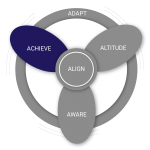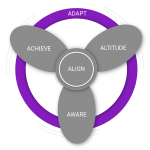What are your leadership strengths? What are your weaknesses? Being able to utilise your leadership strengths can have a significant impact on your leadership and how you lead your team.
There are 1000’s of leadership traits and behaviours – but we have focussed on this list of 25 based on our experience coaching and facilitating with thousands of supervisors, managers and leaders, both in the last 15 years at Kameleons – Developing Leaders, and the previous 14 as an Air Force Officer.
To get to the top 25, we focussed on leadership behaviours that can both be taught and developed, rather than qualities that are innate or are a result of other behaviours. For example, values such as Honesty and Integrity are all or nothing and have not been included – in our opinion you either have them or you don’t (you can’t be a little bit honest – you are honest or you aren’t). We have also sought to avoid ‘result’ traits such as Trust – which is an admirable trait to possess but is resultant on numerous other leadership traits and is a value bestowed upon someone rather than developed on its own (such as reliability).
Our list of 25 leadership behaviours is focussed around 5 core leadership categories – Alignment, Awareness, Achievement, Altitude (Team behaviours) and Adaptability.
Alignment
- Purpose. To be a good leader, you need to have a clear purpose. Purpose is having both a vision of your future state as well as the desire and drive to get there. Leaders with purpose have the ability to think about the future with imagination and without limit, they have the desire and will to make it happen and the ability to draw others towards it with them.
- Commitment. Committed leaders willingly give their time and energy to the business, team, cause or activity they are involved with. Their ‘all in’ approach is infectious for those around them and often results in higher trust from team members.
- Resilience. Business is full of ups and downs. A resilient leader has the capacity to quickly recover from difficulties and persevere when others might falter. Resilience breeds resilience in team members, often resulting in greater perseverance and higher results. A resilient leader has a positive impact on their team; a leader who gives up or falters when things are difficult has a negative impact.
- Goal Oriented. A goal oriented leader sets clear and easily understood goals for themselves and their team, they are driven to achieve them. Goal-oriented leaders are more likely to remain motivated, meet the objectives that have been set for them and achieve targets and deadlines. While time management, planning and attention to detail ensure that things get done, a positive mindset to goals and achievement is just as important.
- Transparency. Truly transparent leaders cannot, and do not conceal anything – be it facts, emotions, details or body language. Transparent leaders cannot or do not hide or conceal anything – can including how the match between their body language and what they say – their appear to be in complete congruence. A transparent leader is clear and easy to understand, significantly increasing the trust that their team and the peers feel for them. A transparent leader does not have to tell their team everything – but they are clear and open regarding what they can and can’t share.
Awareness
- Reflection. Reflective leaders have the ability to think back, observe themselves in action, and to learn from it, making self-reflection a powerful leadership tool. It takes time, effort, serious thought, consideration and the right mindset to be a reflective leader. Leaders often suffer from a lack of external feedback on performance – with this absence the skills of learning through self-reflection and action is crucial.
- Self-Awareness. Self-aware leaders have a conscious knowledge of their own character and feelings. Self-aware leaders have a greater ability to maintain calm and control in difficult situations, and are less likely to have a negative emotional response in dynamic situations. A leader who is self-aware and in tune with how they feel on a topic is likely to make a rounded decision based on more than just facts and data.
- Confidence. A confident leader displays a self-assurance arising from an appreciation of their own abilities or qualities. A confident leader neither undersells or overstates their abilities when dealing with others. Like resilience, transparency and purpose, confidence from a leader can improve the confidence of their team. A confident team is more likely to achieve high performance, not being afraid to take calculated risks or be held back by doubt or irrational fear.
- Assertiveness. Assertive leaders have the ability to stand up for your own or other people’s rights in a calm and positive way, without being either aggressive, or passively accepting ‘wrong’. Rather than being ‘pushy’ or ‘bossy’, assertive leaders display a confident and forceful personality, that is both direct and clear. A leader who is assertive is assertive behaves confidently and is not frightened to say what they want or believe.
- Personal Fulfilment. Leaders that have a focus on personal fulfilment have a satisfaction or happiness as a result of fully developing their potential. This should not be confused with being self-serving – it is an alignment of purpose, desire and drive as a leader seeks to achieve their goals. A leader that is not personally fulfilled in what they are doing can drag down their own (and their team’s performance).
Achievement
- Responsibility. Responsibility is a cornerstone of good leaders. A responsible leader accepts and owns the fact that they have a duty to deal with something or have control over someone (or a team). A responsible leader has accepts the ability to respond – ‘response – ability’ – and demonstrates the ability to hold themselves to account for your behaviours and actions.
- Planning. Good leaders follow the mantra of ‘failing to plan is planning to fail’. Rather than being stuck in a constant planning (and no action) cycle, good leaders plan ahead, set milestones and checkpoints and adjust the plan as needed to ensure the greatest opportunity for achievement.
- Time Management. Good leaders understand that time is a valuable and finite resource and seek to maximise the use of their (and their team’s) time on worthwhile activities. Good leaders are good time managers because they maximise their ability to achieve in the time they have available, and understand the difference between quality and quantity time. A good leader knows when and where they are likely to achieve their best work and plan their time accordingly.
- Attention to Detail. A leader who is focussed on attention to detail has the ability to be thorough and accurate when accomplishing a task, and when checking the tasks of others. A leader focussed on detail can ensure that high standards are achieved and maintained for themselves and others. Good leaders with this behaviour know when not to get ‘bogged down’ in detail, but how to use it to maximum benefit.
- Problem Solving. Problem solving is the process of finding solutions to difficult or complex issues, which is often the expectation of good leaders. A good leader knows not only how to solve problems for themselves and their team, but also how to utilise the skills of others to achieve the same.
Altitude (Team Leadership)
- Accountability. Leaders that demonstrate accountability are willing and able to hold someone to task for their behaviours and their actions. Lack of team accountability results in objectives and tasks being delayed, trust in team members eroding and the standing of your team diminished. A leader that holds the team to account achieves more and is more likely to be respected.
- Active Listening. ‘Active listening’ means to fully concentrate on what is being said rather than just passively ‘hearing’ the message of the speaker. Leaders that demonstrate active listening retain more information, appear more engaged with their team and development trust quicker than those that don’t.
- Verbal Communication. Verbal communication is the use of sounds and words to express yourself, especially in contrast to using gestures or mannerisms (non-verbal communication). Leaders that speak well with their team articulate their message more clearly, have their instructing more readily understood, represent their team in the best light and have less re-work presented to them.
- Empathy. Leaders that display empathy have the capacity to understand or feel what another person is experiencing from within their frame of reference ie. the capacity to place themselves in another’s position. Empathic leaders are not weak – their ability to be in tune with their team members lets them adjust workflow and expectations across the team, anticipate personnel issues and solve people problems often before they arise.
- Constructive Feedback. Constructive feedback is information-specific, issue-focused, and based on observations. Leaders that can praise and criticise performance constructively and rationally through feedback have the ability to improve morale, address problems, limit performance ‘drifting’ off track and improve trust with their team.
Adaptability
- Empowerment. Leaders who empower their team give over power and authority to their team through delegation to get specific things done. Empowerment allows employees to take initiative and make decisions to improve service and performance. Leaders low in empowerment behaviours are forced to make most team decisions on their own, reducing their effectiveness and limiting the confidence, competence and satisfaction of their team.
- Interaction. Highly interactive leaders are enthusiastic with others, embrace new situations, are curious to make new contacts and look for connections between individuals and teams. Low interactive leaders are more insular, prone to solving problems and issues on their own and limit their ability to use others to achieve tasks and goals.
- Adaptability. An adaptable leader is someone who is able or willing to change in order to suit new or variable conditions. Adaptable leaders can see changes in work environment, culture and mood and adjust accordingly. Leaders with low adaptability can get fixated on processes and rules and miss time-based opportunities.
- Influence. Leaders with high influence behaviours have the ability to have an effect on the character, beliefs, opinions, development and behaviour of their team and the people around them. Leaders with influence can use their words and example to change the tone or direction of an argument. Leaders with low influence behaviours will work harder to be heard and will take longer to have their ideas implemented.
- Dependability. A leader who is highly dependable elicits confidence and trust from their team, peers and clients. You can rely on them to do what they said they would do, at the time they said it would be done, to the standard expected. A leader with low dependable behaviours slowly erodes the confidence of their team, consistently fails to meet performance expectations and reduces their overall efficiency and effectiveness.
What are your top 3 strengths when it comes to your leadership behaviour (check against the list above). What are your 3 areas of greatest development? More importantly, what are you going to do to maintain your strengths and develop your weaknesses?
If you don’t know what the strengths and weaknesses are in your leadership behaviour, chances are it is having an impact on your ability to do your job effectively, and most likely having an impact on your team.
To get an accurate picture of your strengths and weaknesses against our Top 25 Leadership traits, enquire with us to complete the Velocity Leadership CheckPoint. It measures your current behaviour against the Top 25, and gives a clear picture of how you can utilise your strengths and develop your weaknesses. Complete the CheckPoint and complete a debrief of your results with one of our highly skilled leadership coaches, to set a path for your leadership growth.









